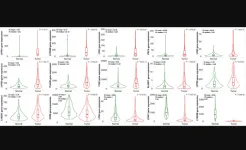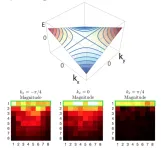(Press-News.org) The race is on to provide high speed satellite internet to the Earth’s most remote areas. New tech companies such as Starlink, One Web, and Amazon’s Kuiper are competing with traditional, established “satcomm” companies such as Thuraya and Inmarsat to provide global high speed, low latency satellite internet across the globe. These new mega-constellations rely on tens of thousands of small low earth orbit satellites flying at a few hundred miles altitude.
Network interconnectivity is a basic building block for providing the fastest, more reliable coverage to end users. While all these mega-constellations are driven to provide high quality of service, they do not currently connect to or interact with one another.
Virginia Tech, together with partners from George Mason University, has been awarded a $2 million grant from the National Science Foundation (NSF) to change this. Through the agency’s Computer and Information Science and Engineering Community Research Infrastructure (CCRI) program, researchers will develop distributed, mobile space and terrestrial networking infrastructure for multi-constellation coexistence.
Principal investigator Jonathan Black, along with fellow Virginia Tech engineering faculty, has teamed with George Mason University to develop a network test bed called SpaceNet for the industry standard technology behind internet satellite constellations. This project is built on the initial trans-Atlantic test bed developed through a Commonwealth Cyber Initiative-supported program in collaboration with the University of Surrey in the United Kingdom.
“The NSF grant will support open-source cyber-infrastructure development and enable research on the creation of a new space-based networking technology that will connect networks from the surface of the Earth to the moon,” said Black, a professor in the Kevin T. Crofton Department of Aerospace and Ocean Engineering. “The goal is to open up these networks to all, uniting separate, independent constellations and encourage broad adoption of this technology.”
The research team will investigate methods, protocols, standards, and new technologies by which various satellite constellations and the networks they host communicate directly with others and themselves, creating a common framework for inter- and intra-constellation communications. A hardware-in-the-loop test bed currently in early development will set industry standard technology behind internet satellite constellations, optimize routing protocols, and ensure the protection of users and communications.
Can you hear me now?
While there are billions of internet users, most don’t think twice about how their connections are routed or what network they are using – unless of course the signal is weak or drops out entirely. On land, if one cell tower or access point is in high demand, traffic is automatically rerouted to another one nearby or the provided data rates drop to accommodate additional users.
In stark contrast, space-based communications are siloed. Mega-constellations of satellites follow their own operational models and standards, have unique communications protocols, and simply don’t connect to satellites outside their constellation.
Mega-constellations consist of small low earth orbit satellites orbiting at a few hundred miles altitude as opposed to the previous generation of large geostationary communications satellites at ranges of over 22,000 miles. Shorter distance allows for lower power devices to connect directly to the satellites and the networks to achieve lower average latency.
However, the low earth orbit position means a single satellite is only overhead for a few minutes on average, requiring new links to be established dozens of times per hour. This fast-changing network topology with shifting connectivity and latencies creates challenges in routing and transport protocols, requiring re-architecting in near real-time.
By exploring how mega-constellations might interconnect without revealing private constellation or network data, we move one step closer toward creating the equivalent of interdomain routing for space networks.
“Through development of the core infrastructure and implementing cybersecurity protocols, we hope to demonstrate the value and practicality of an open-sourced inter-constellation network that has benefits on a global scale,” said Black.
Reach out and touch someone
Earlier this year, with support from the Commonwealth Cyber Initiative, the team at Virginia Tech partnered with the University of Surrey to build the world’s first hardware-in-the-loop test bed that emulates the changing connectivity of a mega-constellation at scale. The first phase includes an initial prototype with hardware at both universities, able to test and validate communication to one another as well as with virtual satellites.
Moving forward, the NSF grant will support a second phase of the test bed, called SpaceNet, and further development of the network infrastructure over the course of three years. The research team will build a testing environment that accurately models the network and dynamics; execute routing and re-routing data link tables on the fly, scaled to multiply-redundant algorithms and architectures; develop satellite-like lab hardware for testbed nodes; and incorporate virtual nodes and remote access for government, industry, and academic researchers.
To ensure that future space communications remain secure from hacking or cyber-threats, the team also will investigate software vulnerabilities and the physical security of satellites, ground stations, and other space infrastructure components, as well as develop management strategies for space infrastructure.
According to research associate Samantha Kenyon, the team plans to build up the infrastructure and bring in a cross-section of multidisciplinary experts and technologies into the test bed. Faculty from Wireless@VT, a research group within the Bradley Department of Electrical and Computer Engineering at Virginia Tech, will bring expertise in communications networks, protocols, and 5G network implementations. Faculty from the aerospace and ocean engineering department will take point on the test bed space-traceable hardware and system dynamics.
Faculty at George Mason University will help integrate the hardware-based 5G terrestrial network test bed and virtual constellation network. These capabilities will greatly enhance the SpaceNet platform and allow users and researchers to conduct multi-constellation networking and satellite-terrestrial experimentation.
“While I am eager to see what we will be able to achieve in our test bed technology, the exciting part is how we can organize and form a coalition of researchers, not only across departments at Virginia Tech but with collaborators at universities across the commonwealth,” said Kenyon. “As a group, we can address all these complex research questions and get more people engaged in the development of the infrastructure.”
Key Virginia Tech collaborators in this project include faculty from the Kevin T. Crofton Department of Aerospace and Ocean Engineering, the Bradley Department of Electrical and Computer Engineering, the Virginia Tech National Security Institute, the Center for Space Science and Engineering, and the Commonwealth Cyber Initiative.
END
Virginia Tech, George Mason University partner to develop networking infrastructure for satellite constellations
2023-05-09
ELSE PRESS RELEASES FROM THIS DATE:
Lifu Huang receives NSF CAREER award to lay new ground for information extraction without relying on humans
2023-05-08
Considering the millions of research papers and reports from open domains such as biomedicine, agriculture, and manufacturing, it is humanly impossible to keep up with all the findings.
Constantly emerging world events present a similar challenge because they are difficult to track and even harder to analyze without looking into thousands of articles.
To address the problem of relying on human effort in situations such as these, Lifu Huang, an assistant professor in the Department of Computer Science and core faculty at the Sanghani Center for Artificial Intelligence ...
LY6 gene family: potential tumor antigens and prognostic biomarkers in endometrial cancer
2023-05-08
“Importantly, the expression of several LY6 genes is elevated in UCEC [uterine corpus endometrial carcinoma] when compared to the expression in normal uterine tissue.”
BUFFALO, NY- May 8, 2023 – A new research paper was published in Oncotarget's Volume 14 on May 4, 2023, entitled, “Human LY6 gene family: potential tumor-associated antigens and biomarkers of prognosis in uterine corpus endometrial carcinoma.”
The human Lymphocyte antigen-6 (LY6) gene family has recently gained interest for its possible role in tumor progression. In this new study, researchers Luke A. Rathbun, Anthony M. Magliocco ...
Atmospheric research provides clear evidence of human-caused climate change signal associated with CO2 increases
2023-05-08
Woods Hole, Mass. (Monday, May 8, 2023) -- New research provides clear evidence of a human “fingerprint” on climate change and shows that specific signals from human activities have altered the temperature structure of Earth’s atmosphere.
Differences between tropospheric and lower stratospheric temperature trends have long been recognized as a fingerprint of human effects on climate. This fingerprint, however, neglected information from the mid to upper stratosphere, 25 to 50 kilometers above the Earth’s surface.
“Including this information improves the detectability of a human fingerprint by a factor of five. Enhanced detectability occurs because the mid ...
UC Irvine, NASA JPL researchers discover a cause of rapid ice melting in Greenland
2023-05-08
Irvine, Calif., May 8, 2023 – While conducting a study of Petermann Glacier in northwest Greenland, researchers at the University of California, Irvine and NASA’s Jet Propulsion Laboratory uncovered a previously unseen way in which the ice and ocean interact. The glaciologists said their findings could mean that the climate community has been vastly underestimating the magnitude of future sea level rise caused by polar ice deterioration.
Using satellite radar data from three European missions, the UCI/NASA team learned that Petermann Glacier’s grounding line – where ice detaches from the land bed and begins floating in the ocean – shifts substantially ...
A new twist on chirality: researchers extend the concept of directionality and propose a new class of materials
2023-05-08
It is often desirable to restrict flows—whether of sound, electricity, or heat—to one direction, but naturally occurring systems almost never allow this. However, unidirectional flow can indeed be engineered under certain conditions, and the resulting systems are said to exhibit chiral behavior.
The concept of chirality is traditionally limited to single direction flows in one dimension. In 2021, however, researchers working with Taylor Hughes, a professor of physics at the University of Illinois Urbana-Champaign, ...
New York’s fertility rate drops, average age of mothers rises
2023-05-08
ITHACA, NY – A decline in New York’s childbirth rate is showing no sign of reversing and many women are waiting longer to have children, according to newly compiled data from the Program in Applied Demographics (PAD) in the Cornell Jeb E. Brooks School of Public Policy.
In 2011, about 241,312 were born in New York. In 2021, that number was 210,742 – a 13% decline.
New York state’s total fertility rate (TFR) – the average number of births a woman would have in her lifetime if current patterns continue – dropped from ...
Department of Energy announces $45 million for Inertial Fusion Energy (IFE)
2023-05-08
WASHINGTON, D.C. – Today, at the celebration ceremony of the historic achievement of fusion ignition at the National Ignition Facility (NIF), the U.S. Secretary of Energy Jennifer Granholm announced a plan to provide up to $45 million to support Inertial Fusion Energy (IFE) research and development.
Fusion, the process that powers the sun and stars, has the potential to provide clean, safe, and reliable carbon-free energy on earth. Harnessing fusion energy is one of the greatest scientific and technological challenges of the 21st century. Fusion requires the fuel to ...
The ability to chew properly may improve blood sugar levels in patients with Type 2 diabetes
2023-05-08
For release: May 8, 2023
Contact: Mary Durlak, durlak@buffalo.edu
University at Buffalo
716-645-4595
The ability to chew properly may improve blood sugar levels in patients with Type 2 diabetes
BUFFALO, N.Y. – If you’re a health care provider treating people with Type 2 diabetes (T2D), University at Buffalo researcher Mehmet A. Eskan has this suggestion for you: check your patients’ teeth.
In a study published in PLOS ONE on April 14, Eskan demonstrates that patients with T2D who have full chewing function have a blood glucose level that is significantly lower ...
Drug industry’s carbon impact could be cut by half
2023-05-08
ITHACA, N.Y. – In a first-of-its-kind analysis, Cornell University researchers and partners found that pharmaceutical producers could reduce their environmental impact by roughly half by optimizing manufacturing processes and supply chain networks and by switching to renewable energy sources.
Pharmaceutical manufacturing is a major contributor to global greenhouse gas emissions, similar in magnitude to the automotive industry, though it has not received anywhere near the level of academic or regulatory ...
Clearing the runway: Modeling a realistic supply chain for bio-based jet fuel
2023-05-08
Oak Ridge National Laboratory scientists led the development of a supply chain model revealing the optimal places to site farms, biorefineries, pipelines and other infrastructure for sustainable aviation fuel production.
The project focused on carinata, a hardy, oil-rich plant targeted as a winter bioenergy crop in Georgia. Scientists used geographical data to model facilities to grow, harvest, store, process and deliver carinata-based fuel at the lowest cost and carbon intensity.
“Our model is unique in capturing the fuel’s life-cycle carbon footprint,” said ...






